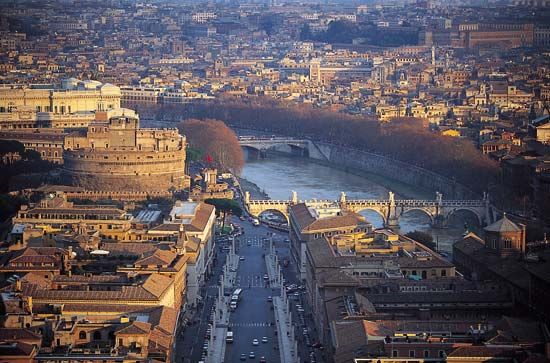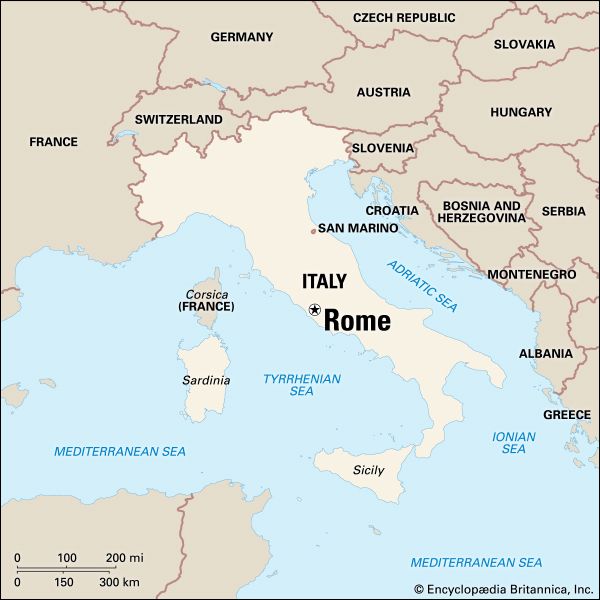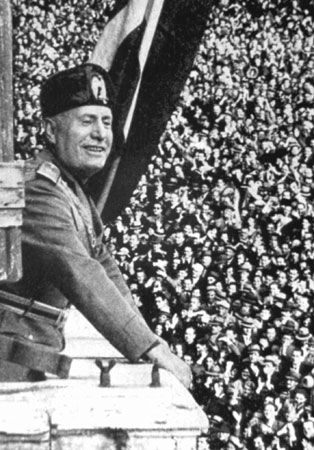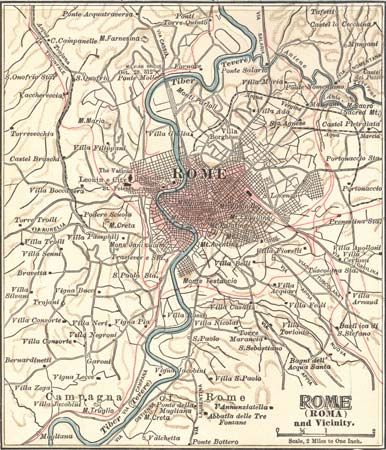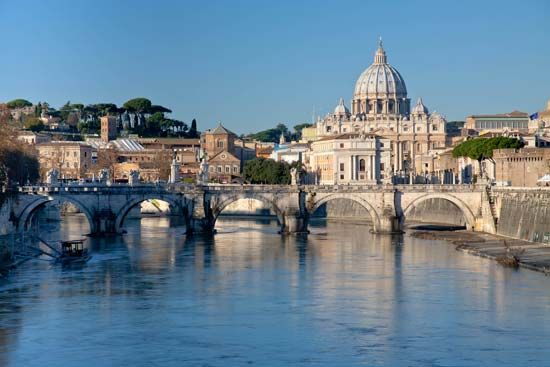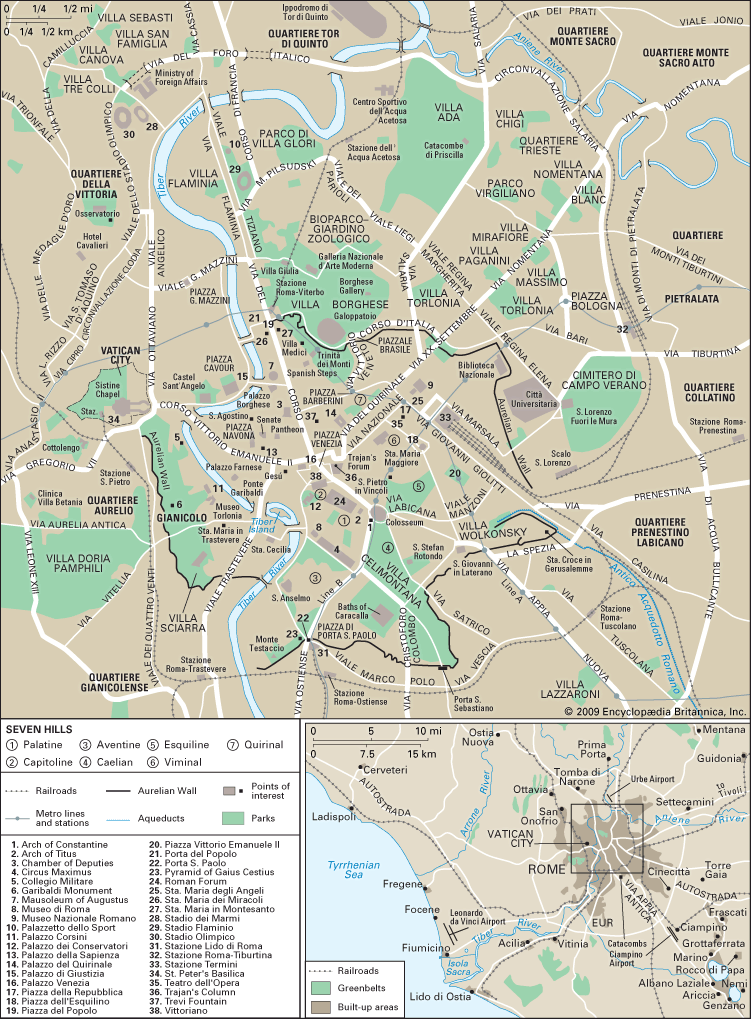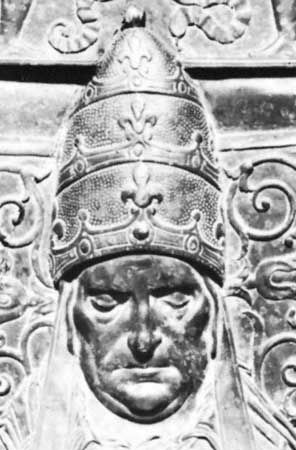- Italian:
- Roma
News •
Decay of imperial authority
In 476 Odoacer, the first barbarian king of Italy, took power—symbolizing the fall of the western half of the Roman Empire. In the 6th century Justinian I, the emperor of the surviving eastern half (the Byzantine Empire), began his attempt to restore Roman imperial rule in the West. His ultimate success, however, was disastrous for Italy and for Rome. Three times Rome was under siege; its aqueducts were cut, and once it was abandoned by its inhabitants. By the end of the century, with the urban population fewer than 50,000, civil authority and the responsibility for protecting the city were in the hands of the church. Pope Gregory I tried to provide an adequate urban administration, and for nearly two centuries his successors played a similar role.
In the middle of the 8th century, when the Byzantines were no longer able or willing to supply Rome with adequate military aid, the papacy turned to the Franks. The Donation of Pippin III—who owed his new title as king of the Franks in part to the pope—granted the pope rights over large territories in central Italy. This act was the theoretical foundation of the temporal power of the papacy. In 774 Pippin’s son Charlemagne conquered the Lombard kingdom in Italy, and in 800 he was crowned emperor by Pope Leo III and acclaimed by the people of Rome. The period of the late 8th and early 9th centuries was one of vigorous building and restoration of churches in Rome.
Factional struggles: papacy and nobility
The decline of Frankish authority in Italy led to the renewal of family and factional struggles. After Muslims plundered areas of Rome in 846, Pope Leo IV built a wall around the area of the Vatican, thus enclosing the suburb that came to be known as the Leonine City. From the late 9th through the mid-11th century, Rome and the papacy were controlled by various families from Rome’s landed nobility, with brief interludes of intervention from the German emperors that were the successors of Charlemagne.
After decades of dispute between the Roman nobility and the papacy, the latter was able to establish an uneasy peace in Rome by the end of the 11th century. The papacy, as reformed under Leo IX (1049–54), generally was supported and financed by new Roman families such as the Frangipani and the Pierleoni, whose wealth came from commerce and banking rather than landholdings. Meanwhile, much rebuilding was necessary after the Norman sack of 1084. By this time, the seat of the church had begun to draw many pilgrims and prelates to Rome, and their gifts and expenditures on food and housing stimulated a considerable flow of money. Although Rome had a population of fewer than 30,000 (occupying less than one-quarter of the lands within the old walls), it was becoming once again a city of consumers dependent on the presence of a governmental bureaucracy.
Emergence of the Roman commune
A revolution in 1143 resulted in Rome’s establishment as a commune, or self-governing city. The uprising had fundamentally the same goals as other contemporaneous communal movements in northern Italy: freedom from episcopal (in Rome’s case, papal) authority and control of the surrounding countryside. The revival of the Roman Senate and other echoes of the Classical past perhaps owed something to the preaching of Arnold of Brescia, a priest and monk who said strong things against ecclesiastical property and church interference in temporal affairs. Rome’s new republican constitution survived both papal and imperial attack alike, and in 1188 Pope Clement III recognized the communal government. In theory, the senators were to become papal vassals, but, in fact, the pope had to make large cash payments to the senators and other communal officials. In the 1190s a single senator was able to exercise wide authority in the territories surrounding Rome.
Pope Innocent III made it his first order of business to secure a firm papal position in Rome and in the Vatican. Only moderately successful, he found it expedient to support the Roman commune’s expansionist policies. Territorial rivalry between Innocent’s family and the Orsini family led to rioting and finally open warfare in the streets of Rome in 1204, during which siege machines destroyed many ancient buildings. After a settlement, Innocent’s many charitable projects won him Roman support.
Pope Gregory IX and the Roman commune clashed over Rome’s expansionist policies and its claims to the right to tax the clergy and church property. The situation was complicated by bitter struggles with the Hohenstaufen emperor Frederick II (ruler of the Holy Roman Empire, the descendant of Charlemagne’s Frankish empire, in western and central Europe), as well as the varied interests of Rome’s leading families—the Orsini, the Savelli, the Annibaldi, and, above all, the Colonna. After Frederick’s death, an antipapal regime promoted a rising middle class and a resurgence of the commune.
Period of the Avignon papacy
Few popes in the second half of the 13th century were able to reside in Rome. In the 1280s and ’90s Rome was torn by the bitter rivalries between the Colonna, Orsini, and Annibaldi families, a discord encouraged by Pope Boniface VIII, and in 1309 Clement V moved the papal residence to Avignon in France. Rome was left to its factional strife and its economic impoverishment. (See also Avignon papacy.)
Yet, in spite of sharp rivalries, Roman and papal interests had often coincided throughout the 13th century. Since Rome was never an important industrial or commercial city, its citizens, from the small shopkeepers and innkeepers to the great banking families, had depended economically on the presence of the papal Curia and the large numbers of pilgrims, prelates, and litigants it brought to Rome. The many brick campaniles of its Romanesque churches and the analogous fortress towers on the palaces of its leading families symbolized Rome’s singular, ecclesiastical character. Nevertheless, with a population never more than 30,000 in the 13th century, it retained a village air for all its urbanity and Classical aspirations. Most of the populace was concentrated around St. Peter’s Basilica and in the low-lying areas of the Campus Martius and Trastevere; large sections of the city within the old Aurelian Wall were pastures, gardens, vineyards, and wastelands.
The popes in Avignon, especially Benedict XII (1334–42), were able to maintain a tenuous rule over the city. The brief popular revolution (1347) of Cola di Rienzo—who, styling himself tribune of Rome, combined apocalyptic visions with ideas of a renewal of Rome’s ancient glories—had more dramatic than political impact. The terrible mortality of the Black Death reduced Rome’s population to less than 20,000, and the city staggered through the last half of the 14th century still racked by factional strife. The return of the papacy from Avignon in 1377 did not help. About 1400, Rome was described as a city filled with huts, thieves, and vermin, and wolves could be seen at night in the neighbourhood of St. Peter’s.
The city in the Renaissance
The entry of Pope Martin V (a member of the Colonna family) into Rome in 1420 marked the beginning of the Renaissance city and of the absolute papal rule that lasted until 1870. Although Martin was neither a builder nor a patron of the arts, he laid the foundations of government that made Rome the capital of a Renaissance state. From this period the apostolic vice chamberlain, as governor of Rome, controlled municipal offices, communal finances, and the statutes of the city. The Roman commune was transformed into a unit of authoritarian papal rule, and the surrounding Papal States (the various territories of the pope in central Italy) increasingly came under the firm control of papal officials.
During the 15th-century pontificates of Nicholas V and, especially, Sixtus IV, the squalid narrow streets of medieval Rome were widened and paved, and new Renaissance buildings replaced crumbling structures. At the same time, the monuments of ancient Rome suffered further damage as they were torn apart for their building materials, and their marble went too often into the lime kilns rather than into new structures. However, the popes attracted scholars and artists from across Italy, and by the end of the 15th century Rome had become the principal centre of Renaissance culture. The high point was reached under Leo X (reigned 1513–21), with his plans for the new St. Peter’s and his patronage of such artists as Michelangelo and Raphael.
Rome flourished economically under the Renaissance popes. Banking and the exploitation of alum deposits near Civitavecchia by the popes (with the help of the Medici family of Florence) stimulated a flow of capital into the city. Rome once again had become a great consumer of imported luxuries, yet it still had little large-scale industry or commerce.

